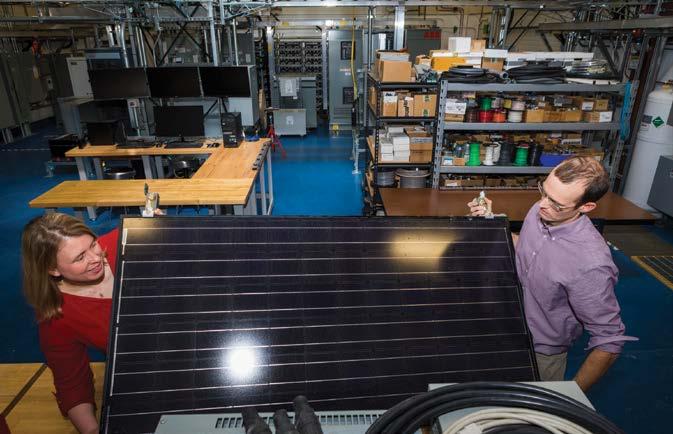
19 minute read
EDUCATION
ACEP's Erin Whitney and Chris Pike with a solar panel in the Energy Technology Facility at the UAF campus.
Amanda Byrd | ACEP
Educating Industry
Private sector leans on University for innovation, answers
By Danny Kreilkamp
Back in April, Alaska Business explored some exciting developments in the state’s geothermal industry. In “Heating Up,” we spoke with Gwen Holdmann, who is not only one of Alaska’s most respected thought leaders on geothermal but also the director of UAF’s Alaska Center for Energy and Power (ACEP).
Our conversation ran the gamut from early versions of Organic Rankine cycle generators to the steps necessary for developing a national energy strategy.
At one point, Holdmann touched on a previous project at Pilgrim Hot Springs where her team at ACEP combined basic thermal imaging with a novel data processing technique that offered a more comprehensive look at the area’s geothermal resources.
She noted that by using this method, her team was able to identify thermal signatures that were well away—almost a mile—from the primary hot spring area.
“And that’s the first time we’ve identified that the overall footprint of that system is much larger than just the signature at the surface.”
This finding served as the groundwork for their 2013 project, and based on the overall results of their research, a power purchase agreement was signed between the City of Nome, the landowner, and a private developer regarding a 2 megawatt power plant. The project is still in the works today.
The importance of projects like these, and their applications to Alaska industry, can’t be understated.
“People don’t always understand the value of research being conducted at the University. I come from an industry background and I really value what the University can contribute. This is a perfect example of innovation and
innovative techniques that were pioneered by the University that were then used by private sector to make development decisions,” says Holdmann.
And it turns out—there’s plenty more where that came from.
ACEP is an applied energy research program based at UAF. It was formed over a decade ago with a vision of leveraging university resources and expertise to help solve pressing issues facing Alaska’s energy sector.
The program has grown to include more than sixty researchers, staff, and students, and continues to serve as an invaluable resource for the state.
In a nutshell (which also doubles as the title of ACEP’s latest marketing campaign that consists of a dozen videos detailing recent projects)— ACEP is keeping Alaska’s energy industry competitive.
As Holdmann puts it in her own two-minute clip, the program “is working with our communities and our industries in Alaska to innovate in ways that continue to keep Alaska at the forefront of our energy transition.”
One of the most striking features about ACEP is the sheer number of partnerships they’ve been able to cultivate over what’s been a relatively brief existence. From countless state organizations to establishments like Stanford and the University of Washington, the Fairbanks institution is making waves on a national level. But their influence isn’t just limited to academic circles. Nor is it falling on deaf ears.
“We try very hard to be an objective third party entity that doesn’t advocate for policy but provides good technical support to help people make decisions,” says Erin Whitney, ACEP’s director of the Solar Technologies Program. “That’s very different from a nonprofit advocacy organization, for example. And that’s a very fine line that we have to walk; and we walk it very carefully and very consciously.”
ACEP experiences a great deal of outreach from industry representatives that are either seeking expertise directly or hoping to be pointed in the direction of past partners that might be able to help.
But these partnerships can materialize in other ways as well.
“We also meet people at conferences, and a big part of our job is staying abreast of what the developments are and who the players are,” says Whitney. “And that involves making sure we participate in the right forums, get our research out there, and are contributing in a way that adds value to society.”
One of Whitney’s and the Solar Technologies team’s latest projects has them involved in a multistakeholder collaboration with Sandia National Laboratories, research partners in northern Michigan, and Renewable IPP—a local company that develops, builds, and operates utility scale solar farms.
The goal of the project is to test new snow-shedding coatings to be used on solar panels. Alaska and Michigan were chosen as the field sites due to their similar climates and common element of heavy snow fall.
“As part of our field work, we had to find places to test those coatings, and that’s where we’ve formed this great partnership with Renewable IPP to apply the coatings and test them on some of the panels at their Willow array,” she explains.
ACEP's Erin Whitney and Chris Pike talk with Renewable IPP's Jennifer Miller and Christopher Colbert in front of the Willow Solar Farm.
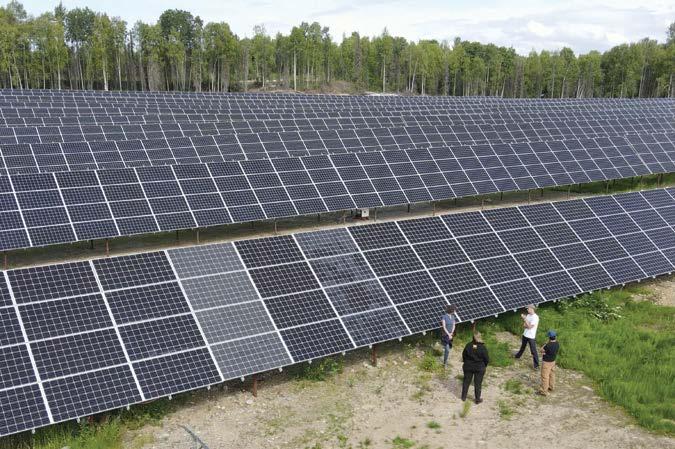
ACEP's Energy Technology Facility operates on the same scale as an Alaska village power plant and is capable of testing a wide range of microgrid generation scenarios.

Amanda Byrd | ACEP
Whitney says partnering with local companies like IPP helps the University stay connected to the industry’s current concerns, needs, and priorities.
The project is coming up on three years now.
“There's lot of considerations and modeling that's gone into this: do these work, are they economically feasible, can they be applied on a large scale, what characteristics do we need… And that's research; it's never as simple as you think it is once you get into it.”
While they don’t have anything ready to go to market tomorrow, Whitney says they’ve gathered some valuable information—not only about the coating tech but about Alaska’s suitability as an environment for solar.
“We do see shedding characteristics in different temperature regimes for the coatings. At certain temperatures the coatings seem to shed snow better than at other temperatures, which is sort of an unexpected and not necessarily favorable outcome. Obviously, you’d like it to shed snow all the time. But the nuance here is that snow falls at a variety of temperatures and it has a variety of humidity levels— all those factors influence how snow bonds to surfaces.
“We’ve certainly learned some very interesting things about coating characteristics, and what works and what doesn’t, and how to potentially design a better coating moving forward in the future. Or maybe apply a totally different strategy: maybe we could heat the backside of the panel, and would that be cheaper economically than trying to coat every panel instead?”
On Alaska’s climate and overall solar potential, she adds: “We have some really interesting performance characteristics of solar panels up here. Our solar panels can be mounted at a steeper angle than elsewhere in the United States because of our sun angles.”
Ground snow coverage can even reflect sunlight back onto the solar panel’s surface if mounted steeply enough, she adds. “And that’s sort of a double whammy of sunlight on those solar panels. And so we actually see very high solar production in the spring months; you’ve got colder temperatures, reflection from snow cover, and a lot more sunlight in that April/May timeframe. "Our crazy sun angles also give rise to thinking about totally new configurations of solar panels, like vertical panels, because we have such high solar azimuth angles. And so there’s just a lot of very different and creative things we can do up here—and the price has come down enough that it’s economically viable.”
UAF and ACEP regularly contribute a wealth of publications that help guide private sector decision making.
The Solar Technologies Program’s Solar Installation Database is particularly useful. It provides all the pertinent details of facility-scale installation systems across the state. “It’s a living document that we invite updates, corrections, and additions to,” says Whitney.
Their annual Railbelt Net Metering Update is another example. Net metering is a utility program that offers rebates to grid-connected customers who have installed distributed generation systems such as solar or wind.
“Both of these materials—the Railbelt Net Metering Update and the Solar Installation Database—are great benchmarks for the solar industry up here. They give them an indication of where the industry is at in regard to rates of installation, it helps inform things like the net metering cap, and it fuels the discussion about whether that cap should be raised or not.”
Different Departments, Same Mission
Identifying rare minerals, like those used in renewable energy applications and other electronic technologies,

Martin Stuefer HyLab Director UAF’s Geophysical Institute can be difficult in a state as vast and geologically diverse as Alaska.
That’s where hyperspectral imaging comes in. And UAF’s Geophysical Institute has the only hyperspectral imaging facility in the state: HyLab.
Hyperspectral imaging (also known as imaging spectroscopy) is an advanced remote sensing technique that analyzes a wide spectrum of light, allowing researchers to measure rather than simply observe from a distance. The technology makes it possible to detect and identify individual minerals in an exposed surface.
Specifically, the Geophysical Institute’s HyLab uses airborne cameras and ground spectrometers to provide detailed maps of an area’s geologic profile. These maps can aid mining experts with their exploration efforts, providing them a more complete picture of an area’s make up.
Alaska has been identified by the US Geological Survey as having “high potential” for containing strategic and critical elements like rare-earth metals. But it continues to be hindered by its challenging geographic environment.
The US Geological Survey also states that hyperspectral imaging can help by its ability to rapidly acquire data about the distributions of surficial materials, including different types of bedrock and ground cover.
Robert McCoy, director of the Geophysical Institute, believes the technology has enormous potential to identify regions rich in critical materials. “Scientists in the Geophysical Institute’s HyLab are ready to work with industry to help find these valuable resources,” he said in a recent press release.
And while HyLab’s headquarters might be a few doors down from ACEP, the overarching mission remains the same.
“It’s a goal for the university to support industrial applications and to help industry and help Alaska’s economy,” says HyLab Director Martin Stuefer. “It’s our goal to help more and to get more involved.”
COVID to Contaminants
Environmental specialists tackle a range of health and safety issues
By Vanessa Orr
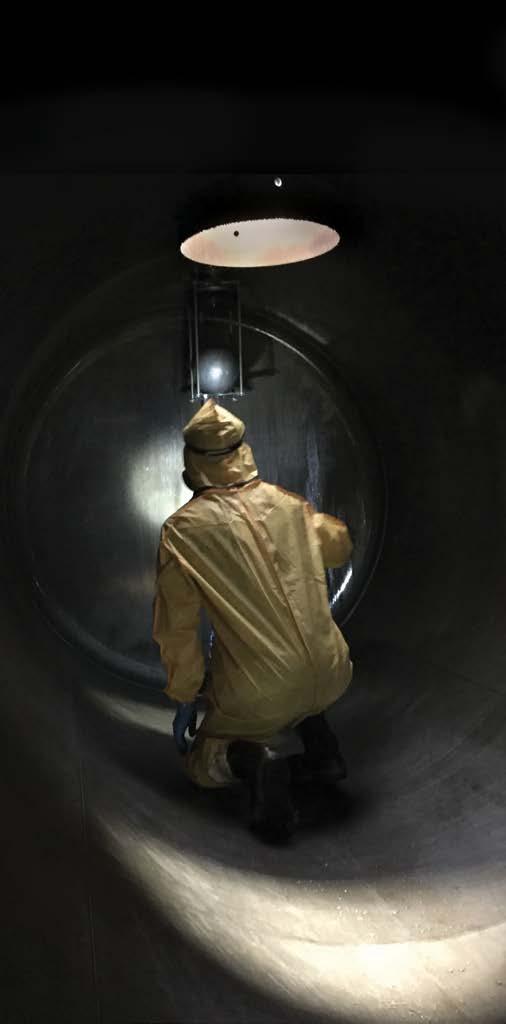
US Ecology O ver the last two years, individuals and businesses have started to pay a lot more attention to keeping their spaces clean— something that, because of COVID-19, took on more importance than ever. And while it’s become commonplace to see cashiers wiping down grocery store conveyor belts and restaurant staff disinfecting seating areas, there are some industries that have always had to put cleanliness and sanitation first for the health of their employees and the general public.
To this end, companies in a variety of fields—from gas stations to energy companies to cruise lines to military bases to air cargo companies and more—hire HSE (health, safety, and environment) specialists or environmental services companies to keep their facilities clean. Not only is this work challenging—imagine the labor involved in cleaning a 24,000-gallon fuel tank—but it can also be dangerous.
“Our job is to find safe ways to perform work on unique jobs in hazardous conditions,” explains Brock Nelson, a field foreman for US Ecology, of the company’s many responsibilities that range from cleaning small or large fuel tanks to dealing with paints, PCBs, POL (petroleum, oil, and lubricant) contaminants, and hazardous waste.
“We also provide a safe and environmentally friendly way to dispose of and recycle waste streams with the least amount of impact on the environment and clean up spills to help restore the environment back to its original state,” adds US Ecology’s Operations Manager Zach Hamilton.
Safety First
While most people try to avoid dealing with hazardous chemicals or putting themselves in situations where they have to mitigate environmental issues, those who do work in the field know the importance of keeping employees safe.
“There are a lot of potential hazards on job sites, but probably the biggest issue is exposure due to equipment or PPE [personal protective equipment] failure,” says Hamilton. “Tears and punctures in PPE can lead to inhalation hazards, as well as the risk of absorbing toxins through the eyes and skin.
“This is why our health and safety measures are so stringent—anything that we can think of that could happen, we prepare for,” he adds.
Pre-planning is key when it comes to identifying and mitigating risk.
“Health and safety is our top priority, so before every task or job, a job hazard assessment is filled out, and we hold tailgate meetings so that everyone involved has an understanding of the hazards and the plan before the work day starts,” says Nelson.
“Our health and safety professionals evaluate each job before sending anyone in to do the work, so all hazards are considered before work is performed,” he continues. “And we all have the authority to stop work at any time to reevaluate tasks if someone feels something has changed during the job.”
If employees are working in an area that is known to have heavy concentrations of lead, for example, employees are monitored throughout the entire job and are pulled from the site if increased lead elevations are detected.
“All of our employees also undergo a yearly physical to ensure their health and to make sure that nothing has changed with that employee,” adds Hamilton.
While some hazards—such as fuel spills—can easily be seen, others, like the COVID-19 virus, cannot.
“At the beginning, everyone was kind of panicked,” says Nelson of the virus that required businesses to decontaminate their facilities and institute strict cleaning protocols to keep employees safe. “We treated it like any other biological hazard, wearing full face respirators, hazmat suits, and rubber gloves—and making sure that all of the seams were closed.”
Wearing full PPE, US Ecology staff sprayed down floors and hightouch areas such as bathrooms with Shockwave, an EPA-registered disinfectant, sanitizer, and cleaner designed for use on various surfaces subject to microbial contamination. It also installed fogging machines for commercial warehouses to decontaminate larger areas. After decontamination, the company followed strict CDC protocols to www.akbizmag.com Take the 49th State’s business world with you anywhere you go with a FREE 1-year digital subscription to Alaska Business that includes:

• Each monthly issue delivered by email • Access to digital edition archives • Exclusive digital edition content • The weekly Monitor newsletter
akbizmag.com/subscribe Promo Code: SUMMER21
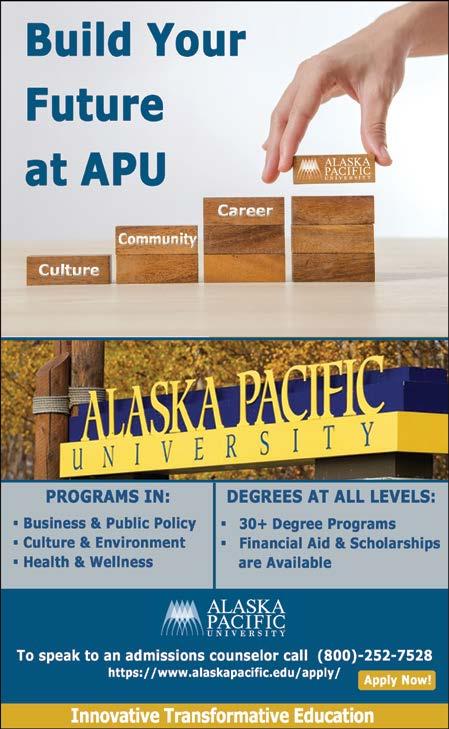
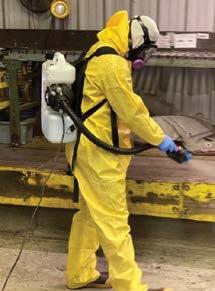
US Ecology employees taking part in a hazardous waste clean-up.

US Ecology
insure that the contaminated PPE was disposed of properly.
This caution extended to US Ecology’s own offices, where social distancing was required and training class sizes were limited.
“We did have to change the way we practiced using equipment in the training classes; you couldn’t have one person using a mask and then passing it on to the next guy,” says Nelson, who added that they instituted more stringent cleaning procedures and also checked everyone’s temperature daily.
While things have calmed since the start of the pandemic, US Ecology still receives client requests to keep facilities COVID-19-free. “At the pandemic’s peak, we were getting calls around the clock,” says Nelson. “Now we get one every couple of weeks to provide decontamination services of this nature. But dealing with a biological hazard at that level—that was definitely a first for us.”
Identifying Hazards
Approximately 50 percent of US Ecology’s projects are planned, such as tank cleanings, and the other half are in response to emergencies, such as a fuel tanker spill.






Nothing unites us like doing good together.

Join us and make a difference. August 21 FairbanksHeartWalk.org
Live Fierce. Take Action. sponsor:
Proudly presented by:
“Depending on what the issue is, we determine how best to attack it,” says Nelson, adding that in a chemical spill, for example, the toxin must first be identified. “Most transport companies carry manifests that have everything documented, so Safety Data Sheets [SDS] are the first identifier that we ask for when we show up,” says Nelson of these OSHA documents that are required for hazardous products or chemicals. The SDS includes information on the properties of each chemical; the physical, health, and environmental health hazards; and protective measures and safety precautions for handling, storing, and transporting them. It also includes emergency control measures.
“For example, if a trailer comes in leaking a clear liquid, we would first ask for all of the safety data sheets for the trailer, and then compare those listings with what we can see and monitor,” says Hamilton. “If there is more than one chemical on the trailer, this helps us eliminate chunks of other hazards. If the liquid is not identifiable, or there is no SDS, we go in under a much higher level of PPE.”
Whether dealing with a planned or unplanned event, the company follows rigorous protocols when working at a site. This includes utilizing 5 gas meters, which detect combustible gases in LEL (lower explosive limit) and/or volume percentage range, oxygen, carbon monoxide, carbon dioxide, hydrogen sulfide, sulfur dioxide, ammonia, chlorine, and VOCs (volatile organic compounds), among other hazardous materials.
“This helps us not only determine what we’re dealing with but how long we can be in the area based on exposure limits, what type of air or ventilation system we need to use—such as pneumatic or explosion-proof fans—what PPE we need to wear, and any other type of specialized equipment that is required for that contaminant,” says Nelson.
In some cases, technology can even be used to clean a site without requiring a human to be placed in harm’s way. The GamaJet GobyJET portable pump system, for example, is a “manless” entry cleaning system that uses global indexing patterns to provide 360 degree tank cleaning, eliminating the need for confined space entry.
Technology has also helped with the equipment that HSE professionals wear while working onsite; while selfcontained breathing apparatus air tanks used to be heavy and hold only 30 minutes of air, they are now lighter and have increased air capacity. Meters are also now more user-friendly, work more quickly, and are more reliable than previous incarnations.
Removing the Waste
While identifying and mitigating an ecological or human hazard can be a challenge, so can its disposal, especially in Alaska, where more stringent regulations don’t allow for certain kinds of waste in the state’s landfills.
“Depending on the type of waste, it goes to various disposal facilities throughout the country such as landfills, incinerators, and recyclers,” says Hamilton, adding that this waste is transported by highway, over water, and sometimes by air. “All shipments are made using DOT-approved shipping papers such as bill of ladings, hazardous waste manifests, non-hazardous
Central Environmental Inc.

The Solutions Company - When experience meets ingenuity
• Safe, cost e ective solutions to the most challenging projects • From the Arctic to the Gulf Coast • Full facility removal, asbestos, remediation, waste management, demolition and site work

CEI I The Solutions Company
waste manifests, and dangerous goods declarations for air transport, depending on how it is regulated.”
While some materials must be completely disposed of, others, like fuel and oil, can be recycled.
“Because technology has changed a lot, we are now able to recycle things that we couldn’t before,” says Nelson. “For example, we use Dolphin separation equipment to drop the sludge and water out of oils so that we can turn around and sell it as burner fuel to asphalt companies and shops that want to use it for heating.
“We try to recycle whatever we can; it really depends on the waste stream,” he continues, adding that through its distillation plant, the company is also able to recycle the glycol antifreeze that it collects.
One of the most important parts of the waste disposal process is keeping track of the waste stream so that clients know that it has received proper disposal.
“We fill out a manifest that identifies the waste characteristics and constituents and also has the generator and the disposal site listed,” says Hamilton. “Shipping papers are used to help track the waste, and at each stop the transporter needs to sign it. Then the original manifest is sent back to the generator so that they know where their waste went, from cradle to grave.”
With so many issues to keep track of, even companies that have their own HSEs in-house often look outside for help.
“A company may have one or two people, but if something ends up happening, such as a larger spill event, they’ll call us in to assist. Or if they are struggling with a solution, they bring us in to give them options for disposal or industrial cleanings,” Hamilton explains. “Sometimes, if a company is working with the state on an issue, the state may also recommend that they get ahold of us to make sure that the site is cleaned to their high standards.”
When hiring outside HSEs or environmental services companies, there are several factors that a company should look for including experience, the ability to provide cost-effective solutions, an exemplary safety record, and the expertise to be able to come up with various plans of attack.
“It is also important that companies have the capability to work in the more remote parts of Alaska and the United States and in all weather conditions,” says Nelson. “They also need to have the available response equipment for spills, rescues, and planned projects,”
He adds, “This is a dangerous line of work and it can be very expensive, so you have to make sure that you’re hiring a company that has the experience and knowledge to do it correctly.”
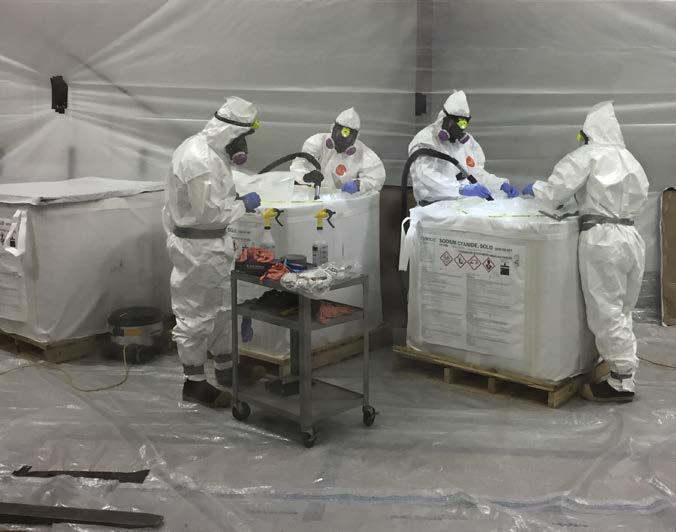
US Ecology staff taking part in Level C PPE shipping container decontamination.
US Ecology











